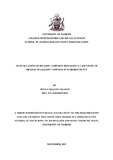An Evaluation of HIVAID Campaign Messages: a Case Study of Mpango Wa Kando Campaign in Nairobi County

View/
Date
2015-11Author
Okaron, Polly S
Type
ThesisLanguage
enMetadata
Show full item recordAbstract
This study intended to evaluate HIV/AIDS Campaign messages only focusing on Mpango Wa
Kando Campaign in Nairobi county. This study had four objectives to achieve: To establish
the extent to which the Mpango Wa Kando HIV/AIDS campaign messages were understood
by the target audiences. To determine the extent to which the Mpango Wa Kando HIV/AIDS
campaign messages were appreciated by the target audiences. To evaluate the diction of
messages used in the Mpango Wa Kando HIV/AIDS Campaign. To investigate the impact of
the HIV/AIDS messages as packaged and conveyed by Mpango Wa Kando Campaign. Both
quantitative and qualitative designs were used in the study. The study population was the
people from Nairobi County and 188 was the sample size of the population comprising of
male and female, married and unmarried, between the ages of 18-40 years as they were
considered to be sexually active. The method of data collection used was use of questionnaires
which was distributed to the respondents. During the study, data analysis was done by using
the Statistical Package for the Social Sciences (SPSS) and Microsoft Excel. The data was
presented in form of tables and diagrams like graphs. The key findings of the study were: the
Mpango Wa Kando Campaign was understood because it was clear and the lessons learnt from
the message included stopping concurrent sexual relations, using a condom in case one is not
able to keep off the relationships. The Mpango Wa Kando Campaign message was appreciated
as the respondents found the message worthy because of its educative nature. The respondents
were able to identify the words used in the campaign and it was clear that the slogan “Wacha
Mpango Wa Kando” (Stop concurrent sexual relationships) used stuck into the audience’
mind. In addition, there were different interpretations of the campaign: The message was
about stopping concurrent relationships, using a condom, being faithful to sexual partners. The
campaign yielded positive behavior change in the personal life of respondents because the
words used by the designers caused behaviour change. Recommendations of the study
included: Women characters should be more involved in the campaign to show the audience
that HIV/AIDS not only affects men but also women. Follow up campaign should be run to
clarify any misinformation the audience may have had from previous campaign. A different
strategy that addresses tangible positive behaviour change rather than focusing on knowledge
should be used. Future studies could be on semantic dynamics by the campaign designers so as
to understand how the audience extends meaning. Negative behaviour catalyst should be
researched on to establish the relationship between knowledge and behaviour change.
Characters in campaign should be analyzed so as to unveil their role in message interpretation
